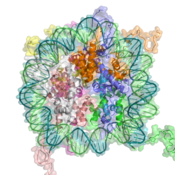صبغين

الكروماتين أو الصبغين Chromatin يوجد على شكل شبكة ووظيفته الأساسية هي تكوين الجينات الوراثية.
يوجد الكروماتين على هيئة شرائط ملتفة من حمض دنا DNA مرتبطة مع البروتينات القاعدية (الهستونات Hestones). ويمثل حمض DNA ، المكون للكروماتين الطراز الأساسي من حمض DNA في الخلية ، وبالتالي فهو الذي يحمل معظم المعلومات الوراثية ، كما أن تخليض أحماض رنا مرسال m-RNA والريبوسومي والناقل يتم بواسطة الكروماتين. وبإستخدام المجهر الإلكتروني يمكن تمييز طرازين من الكروماتين ؛ أولهما هو الكروماتين المخالف الذي يتميز بأنه كثيف إلكترونيا ويبدو على صورة حبيبات كبيرة أو ساحات داكنة ، ويمكن مشاهدته في تحضيرات الميكروسكوب الضوئي بعد إستخدام الأصباغ المناسبة ، أما الكروماتين الحقيقي فهو يرى فقط بالمجهر الإلكتروني ، ويبدو على هيئة شبكة مفككة من الخيوط الدقيقة ، التي لا يمكن لقدرة الإيضاح الخاصة بالمجهر الضوئي إظهارها. وعلى عكس الكروماتين المخالف فإن الكروماتين الحقيقي نشط وراثيا.
بنية الدنا
الكروماتين ومزاوجة القواعد التي قام بها واتسون/كريك

Metaphase chromatin
The metaphase structure of chromatin differs vastly to that of interphase. It is optimised for physical strength and manageability, forming the classic chromosome structure seen in karyotypes. The structure of the condensed chromosome is thought to be loops of 30 nm fibre to a central scaffold of proteins. It is, however, not well-characterised.
The physical strength of chromatin is vital for this stage of division to prevent shear damage to the DNA as the daughter chromosomes are separated. To maximise strength the composition of the chromatin changes as it approaches the centromere, primarily through alternative histone H1 anologues.
It should also be noted that, during mitosis, while most of the chromatin is tightly compacted, there are small regions that are not as tightly compacted. These regions often correspond to promoter regions of genes that were active in that cell type prior to entry into cromitosis. The lack of compaction of these regions is called bookmarking, which is an epigenetic mechanism believed to be important for transmitting to daughter cells the "memory" of which genes were active prior to entry into mitosis. This bookmarking mechanism is needed to help transmit this memory because transcription ceases during mitosis.
كروماتين: تعريفات بديلة
- Simple and concise definition: Chromatin is DNA plus the proteins (and RNA) that package DNA within the cell nucleus.
- A biochemists’ operational definition: Chromatin is the DNA/protein/RNA complex extracted from eukaryotic lysed interphase nuclei. Just which of the multitudinous substances present in a nucleus will constitute a part of the extracted material partly depends on the technique each researcher uses. Furthermore, the composition and properties of chromatin vary from one cell type to the another, during development of a specific cell type, and at different stages in the cell cycle.
- The DNA + histone = chromatin definition: The DNA double helix in the cell nucleus is packaged by special proteins termed histones. The formed protein/DNA complex is called chromatin. The structural entity of chromatin is the nucleosome.
Alternative chromatin organizations
During metazoan spermiogenesis, the spermatid's chromatin is remodelled into a more spaced-packaged, widened, almost crystal-like structure. This process is associated with the cessation of transcription and involves nuclear protein exchange. The histones are mostly displaced, and replaced by protamines (small, arginine-rich proteins).
جوائز نوبل
The following scientists were recognized for their contributions to chromatin research with Nobel Prizes:
| Year | Who | Award |
|---|---|---|
| 1910 | Albrecht Kossel (University of Heidelberg) | Nobel Prize in Physiology or Medicine for his discovery of the five nuclear bases: adenine, cytosine, guanine, thymine, and uracil. |
| 1933 | Thomas Hunt Morgan (California Institute of Technology) | Nobel Prize in Physiology or Medicine for his discoveries of the role played by the gene and chromosome in heredity, based on his studies of the white-eyed mutation in the fruit fly Drosophila.[1] |
| 1962 | Francis Crick, James Watson and Maurice Wilkins (MRC Laboratory of Molecular Biology, Harvard University and London University respectively) | Nobel Prize in Physiology or Medicine for their discoveries of the double helix structure of DNA and its significance for information transfer in living material. |
| 1982 | Aaron Klug (MRC Laboratory of Molecular Biology) | Nobel Prize in Chemistry "for his development of crystallographic electron microscopy and his structural elucidation of biologically important nucleic acid-protein complexes" |
| 1993 | Richard J. Roberts and Phillip A. Sharp | Nobel Prize in Physiology "for their independent discoveries of split genes," in which DNA sections called exons express proteins, and are interrupted by DNA sections called introns, which do not express proteins. |
| 2006 | Roger Kornberg (Stanford University) | Nobel Prize in Chemistry for his discovery of the mechanism by which DNA is transcribed into messenger RNA. |
انظر أيضاً
- Chromatid
- Epigenetics
- Histone-Modifying Enzymes
- Position-effect variegation
- Salt-and-pepper chromatin
- Transcriptional bursting
الهامش
- ^ "Thomas Hunt Morgan and His Legacy". Nobelprize.org. 7 Sep 2012
وصلات خارجية
- Chromatin, Histones & Cathepsin; PMAP The Proteolysis Map-animation
- Recent chromatin publications and news
- Protocol for in vitro Chromatin Assembly
- ENCODE threads Explorer Chromatin patterns at transcription factor binding sites. Nature (journal)


